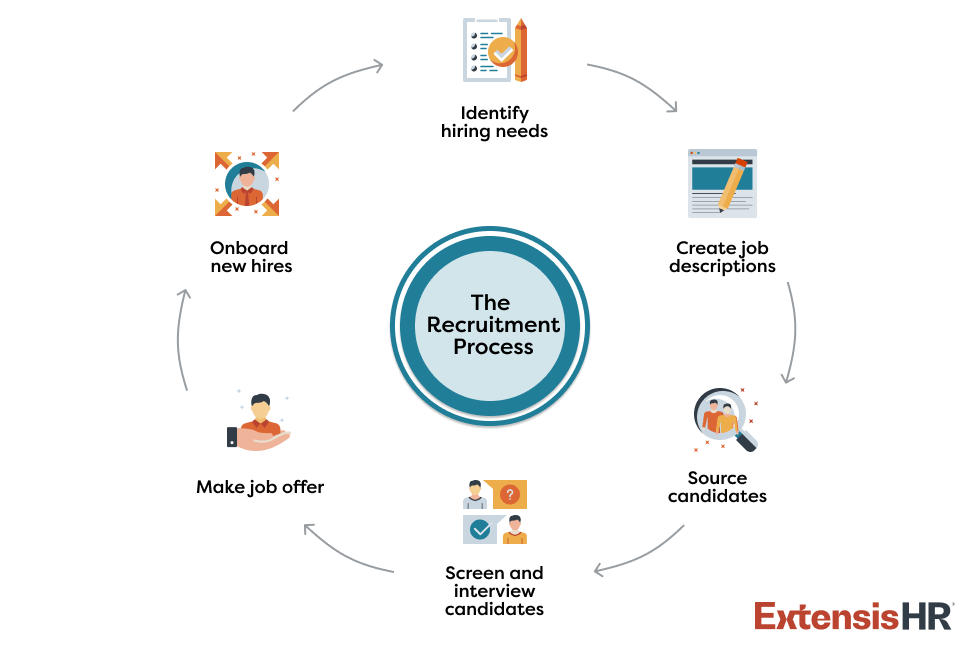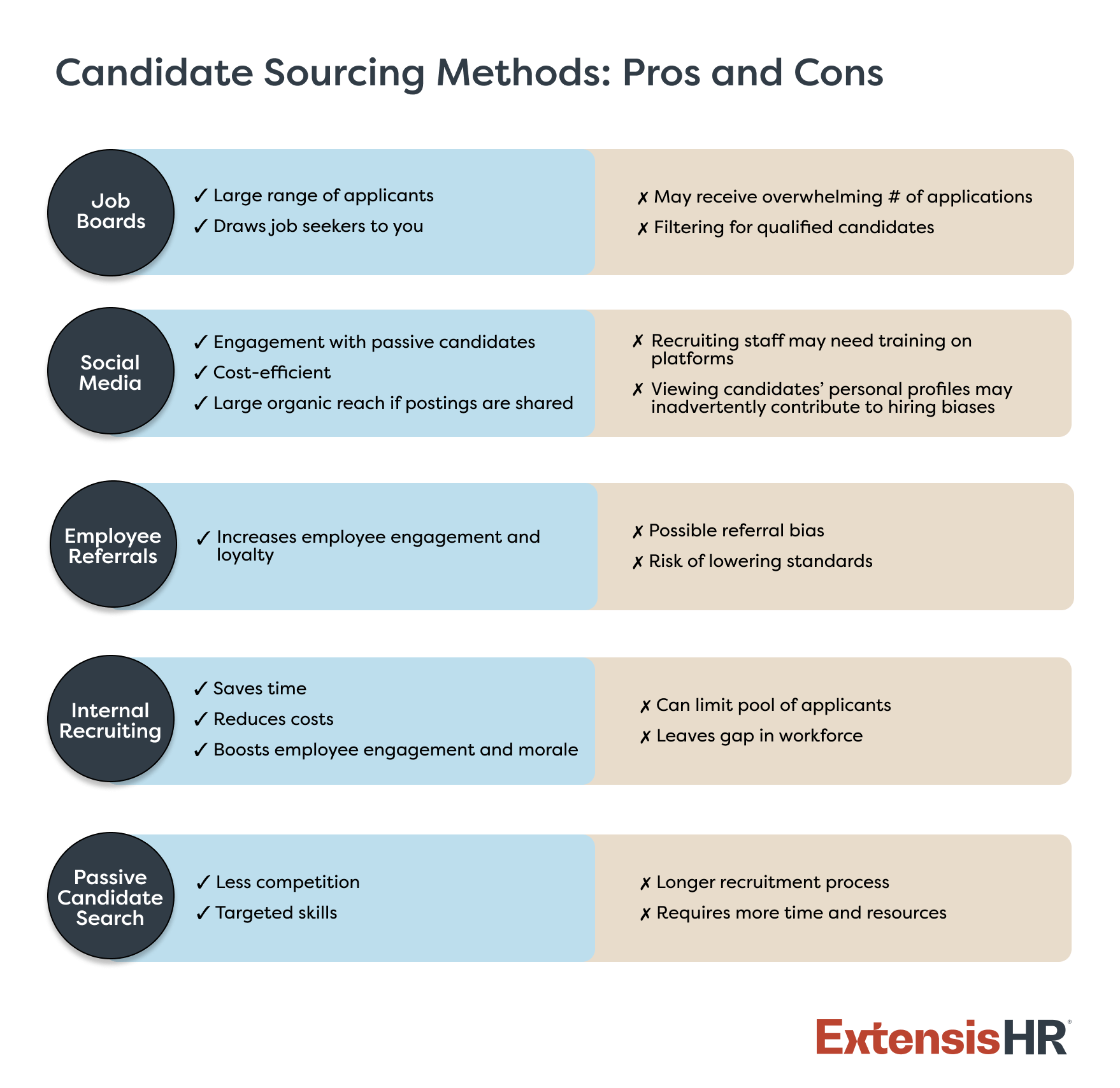What is Recruitment and Talent Acquisition? Tips and FAQs
The heart of every organization is its people. Finding and hiring the right talent is essential for businesses to create innovative offerings, foster a strong company culture, and ultimately improve their bottom line.
This guide defines recruitment and talent acquisition—and the difference between the two. It also provides an overview of the recruitment process, key recruiting best practices, hiring law considerations, current talent acquisition trends, and more.
What is recruitment?
Recruitment is the process of identifying, attracting, interviewing, selecting, hiring, and onboarding employees. It involves creating job descriptions, posting job openings, sourcing candidates, conducting interviews, evaluating applicants, and making hiring decisions.
Typically, recruitment aims to find and hire the best-qualified candidates who fit the company’s immediate needs and align with its culture.
Employees can be recruited internally by promoting or transferring existing staff or externally by hiring new talent from outside the organization.
What is talent acquisition?
Talent acquisition is the process of identifying, attracting, recruiting, and hiring skilled individuals to meet an organization’s staffing needs. It focuses on finding long-term specialists, leaders, or future executives.
Talent acquisition vs. recruitment
The terms “talent acquisition” and “recruitment” are often used interchangeably but their scopes differ. Talent acquisition is a strategic process focused on long-term workforce planning and development, while recruitment deals with immediate hiring needs.
| Talent Acquisition | Recruitment | |
|---|---|---|
| Scope | Strategic and Long-Term: A broader, strategic approach focused on identifying and attracting skilled individuals for the organization’s current and future needs. Talent acquisition encompasses employer branding, workforce planning, and connecting with potential candidates. | Reactive and Immediate: Recruitment is more tactical and requires filling specific job openings as they arise. It is a reactive process triggered by the need to fill a position quickly. |
| Timeline | Ongoing: Continuous effort is made to build a talent pipeline and ensure the organization can meet its long-term goals. | Short-Term: Usually a short-term activity concentrated on making an immediate hire for a specific role. |
| Focus | Roles at All Levels: Particularly focused on filling specialized, leadership, or hard-to-fill roles. | Current Openings: Often involves sourcing, interviewing, and hiring candidates for existing positions. |
| Goals | Building a Talent Pool: Aims to create a robust talent pipeline for the future. Long-Term Fit: Focuses on hiring individuals who will contribute to the organization’s growth and fit the company culture over the long term. |
Filling Vacancies: The primary goal is to fill immediate vacancies with qualified candidates. Short-Term Fit: Concentrates on meeting current hiring needs and may or may not consider long-term or future needs. |
| Key Activities | Proactive Sourcing: Build long-term relationships with candidates, even before a position is open. Employer Branding: Make the organization attractive to top talent by establishing the company as an employer of choice. Data Analysis: Utilize data to forecast hiring needs, understand trends, and improve strategies over time. |
Job Posting and Advertising: Post job openings, screen resumes, and conduct interviews to fill immediate vacancies. Candidate Selection and Hiring: Select the right candidate for a current role and move them through the hiring process as efficiently as possible. |
| Business Impact | Strategic Impact: Contributes to the overall business strategy by aligning the talent strategy with long-term business goals. | Operational Impact: Ensures the business functions smoothly and maintains productivity. |
Recruitment process overview

The recruitment process typically includes six steps:
- Identifying hiring needs
- Creating job descriptions
- Sourcing candidates
- Screening and interviewing candidates
- Making job offers
- Onboarding new hires
Key activities during the talent acquisition process are largely the same, but longer-term initiatives may be more important when identifying hiring needs.
Identifying hiring needs
The first step of the recruitment process is to identify vacancies that exist, whether it’s a newly formed position or you’re looking to replace someone who has left the role.
- Conduct a job analysis: Define the role, responsibilities, and required skills.
- Understand organizational goals and workforce gaps: How does the position contribute to business objectives? How many openings need to be filled, and what is the timeline?
- Establish budget: Conduct salary surveys to ensure you offer a competitive market rate and maintain internal pay equity.
- Prioritize hiring needs: If filling multiple positions, which take precedence? Roles that could halt progress or affect productivity if left unfilled should be prioritized. Additionally, the role should be escalated if it requires specialized skills that the company currently lacks.
Crafting effective job descriptions
Next, it’s time to develop informative job descriptions to ensure you attract the right talent and accurately answer the question, “What will the person in this role do?”
Key job description components include:
- The job title
- Company information, including the business’s name, mission statement, and core values
- Position logistics, such as:
- Department
- FLSA status (salaried, hourly, full-time, part-time, temporary, permanent, consultant)
- Who the role reports to
- Who the role supervises, if applicable
- Job location
- Work environment (on- or off-premises, travel requirements)
- Job details, including:
- The position’s main purpose and how it relates to the company’s mission
- Job responsibilities
- Position requirements, including technical/functional skills, competencies, years of experience, education, etc.
- Pay range, especially if pay transparency laws apply to your organization
- Employee benefits offered
- Disclaimers, such as an equal employment opportunity statement
Clear, concise job descriptions can increase employee satisfaction and reduce turnover by:
- Clearly defining the role: Outlining the position’s responsibilities helps candidates understand what is expected of them.
- Attracting the right talent: Well-written job descriptions engage candidates with the right skills, experience, and qualifications. This can ultimately save organizations time and resources by reducing the number of unqualified applicants.
- Setting expectations: Establishing performance standards aids in developing performance objectives.
- Contributing to professional development: High-quality job descriptions provide a basis for career development, helping employees understand the skills and experience needed for advancement within the organization.
Download a free job description template and more in our recruitment toolkit >>
Sourcing candidates
Once the position is fully defined, it should be promoted to attract qualified candidates and encourage them to apply.
Common methods of sourcing candidates include:
- Job boards: Open positions may be posted on job board sites like Indeed, Glassdoor, etc.
- Social media: Job postings can be shared on various social media platforms by recruiting staff, corporate accounts, or both.
- Employee referrals: Current staff may recommend potential job candidates for open positions within the organization.
- Internal recruiting: Common internal recruiting methods include promotions, transfers, contractor to full-time adjustments, and connecting with former employees.
- Passive candidate search: Connecting with candidates who are not actively seeking new opportunities can help build a talent pipeline for the future.

Screening and interviewing candidates
After your job postings have garnered interest and received applications, it’s time to evaluate and compile a shortlist of top candidates. This process involves screening, interviewing, and comparing applicants.
Screening
Recruiters typically complete screenings, which involve evaluating applicants to determine their suitability for a position. There are various methods for screening candidates, including:
- Telephone or video pre-interview screens involve asking preliminary questions to aid in the interview selection process. These screens typically take 10-15 minutes and include asking questions like:
- Why are you interested in working for our company?
- Do you have a college degree or specific certifications?
- Why do you want to leave your current (or most recent) job?
- What skills and experience do you have directly related to this position?
- What hours are you available to work?
- If we proceed with you as a candidate, when would you be available for an interview?
- Telephone or video full interview screens touch on topics similar to telephone pre-interview screens but more in-depth. More detailed points may be discussed, including:
- Most recent job responsibilities, successes, and mistakes
- Long-term career goals and ideal job criteria
- Resume reviewing involves assessing a candidate’s qualifications and potential fit for the job. Factors to consider include:
- Work history descriptions
- Skills
- Job changes
- Promotions
- Examples of initiative or teamwork
- The resume’s formatting, organization, grammar, and punctuation
- Skills assessments allow recruiters to identify applicants most qualified for the role. Candidates can be evaluated on various soft and technical skills.
- Trial assignments allow candidates to tangibly demonstrate their skills by completing a task that directly relates to the open position’s responsibilities.
Interviewing
Job interviews are typically conducted by a business’s human resources (HR) manager, hiring manager, company executives, and future coworkers.
Various types of interview questions should be asked to gain a well-rounded understanding of a candidate’s experience, skills, and personality:
Opening questions:
- Why did you choose [name of career] as your profession?
- What do you like most about your profession?
- What do you like least, and what do you find most challenging?
- Why did you apply for this position?What are your short- and long-term career goals?
Business acumen questions:
- Describe a time you identified a barrier to your (or to others’) productivity and what you did about it.
- What do you do when someone else is late and preventing you from accomplishing your tasks?
- How do you get everything done when you have a lot of work or multiple priorities?
Behavioral questions:
- What do you think it takes to be successful in this organization?
- Which of your personal qualities do you consider most important?
- How do you typically handle work stress?
Challenging questions:
- Describe a situation in which you saw a problem and took action to correct it.
- Tell me about when you effectively handled an internal or external customer complaint.
- Have you encountered situations in which you became frustrated or impatient when dealing with a peer, team member, or other employee? What did you do?
While meeting with applicants, it’s critical to avoid interview bias. Interviewers must be careful not to ask questions that could lead to discrimination or interview bias, as certain topics are legally off-limits. Interviewers should never inquire about a candidate’s:
- Age
- Marital or family status
- Religion
- Participation in clubs or social organizations
- Disabilities
Many lesser-known types of interview bias exist, including but not limited to:
- First impression bias: When an interviewer uses their perception of a candidate to shape their overall impression of that person.
- Generalization bias: When an interviewer extends the candidate’s behavior during an interview to their general personality and mindset.
- Halo effect: When one positive aspect of a candidate’s resume overshadows their weaknesses.
- Negative emphasis bias: Opposite of the halo effect, this is when a negative piece of information about a candidate outweighs the positive and affects the rest of the interview and/or hiring decision.
- Recency bias: When recent interviews are thought of more positively than earlier ones.
- Similarity bias: When hiring decisions are based on the interviewer’s and candidate’s similar hobbies and traits.
Evaluating and comparing candidates
Once interviews have concluded, candidates should be thoroughly evaluated and compared. Below are some key factors to consider:
- Level of preparation for and professionalism during the interview
- Education and training
- Work experience
- Technical skills
- Supervision/leadership experience
- Interpersonal skills
- Teamwork ability
- Time management
- Customer service skills
- Level of motivation
- Problem-solving abilities
- Positive, legitimate references
- Level of adaptability
Having multiple strong contenders means your recruitment process is effective, but it can complicate the hiring decision. In this situation, using a candidate comparison chart to choose the best-suited candidate objectively can be helpful. You may also consider whether hiring more than one person is feasible or if other relevant openings exist within the organization.
Checking references
References are typically contacted during the final stages of the hiring process and asked about the candidate’s:
- Strengths and weaknesses
- Prior responsibilities
- Overall performance
Ideally, references should be professional contacts who have worked with the candidate, managed them, or have been in a supervisory role.
Making the job offer
Great news! You’ve identified your top candidate and are ready to extend an offer. Here’s what to include in your offer letter and how to present it and gain the candidate’s commitment.
What should an offer letter include?
Job offer letters should include:
- Title
- Name of supervisor
- Full-time/part-time schedule
- Start date
- Salary and benefit information
- Exempt/non-exempt classification
- Vacation time allowances
- Contingencies
- At-will employment statement
- List of required identification documents for eligibility of employment, to be presented on the new hire’s first day
- Confidentiality agreements
- Deadline for response
Note: Certain states may require employers to obtain additional documents.
Download our customizable offer letter template and more in our recruitment toolkit >>
How to present a job offer
Presenting a job offer requires careful planning and clear communication. Ideally, the offer should be appealing and ensure the candidate understands all terms and conditions.
Recruiters often first extend a verbal offer. This involves contacting the candidate to arrange a phone or video meeting to discuss the offer and answer any questions. This is a great time to express your enthusiasm about the candidate joining the company and inform them that a formal offer letter will follow.
The offer letter should then be sent via email as soon as possible after the verbal offer. This is another chance to reiterate your excitement about the possibility of the candidate coming on board. Sometimes, a hard copy of the offer letter is also sent.
Tips on negotiating terms and benefits
Be prepared to discuss any counteroffers or concerns the candidate may have. Respond promptly and professionally if negotiations occur, and document any changes in a revised offer letter.
Ensuring acceptance and commitment
Receiving a signed offer letter back from candidates is a highly anticipated moment. To maximize your chances of that happening, follow up with them a day or two after sending the offer letter to confirm receipt and address any questions they might have.
After the candidate accepts the offer, ensure they sign and return the letter by the specified deadline. Then, they should be given any necessary information about their first day, the onboarding schedule, and any preparatory tasks they should complete. Maintaining regular communication during this time also keeps them excited about joining the team.
Onboarding new hires
The time is here: your new has officially chosen to work at your company, and it’s time to onboard them!
The Society for Human Resource Management (SHRM) defines employee onboarding as “the process of integrating a new employee with a company and its culture.”
Onboarding includes administrative tasks like completing necessary paperwork and setting up computers and technology, as well as establishing role expectations, introducing the new hires to coworkers, and incorporating them into your organization’s culture.
Effective onboarding is associated with multiple business benefits, including:
- Increased employee retention
- Improved job satisfaction
- Elevated productivity
- A stronger understanding of the company culture and the individual’s job responsibilities
- And more
Ideally, onboarding should begin before the first day and last at least 30 days—some organizations even onboard for the entire first year of employment. Below are some tasks associated with each phase of onboarding:
| Before First Day | Prepare employee’s computer and other devices, set up logins Provide itinerary for first week Notify current employees about new hire |
| On First Day | Meet with new hires upon arrival Conduct new hire orientation Provide tour of facility, if applicable Introduce new hires to colleagues |
| First 30 Days | Regular check-ins between new hires and their managers Provide training on more advanced duties Increase number of work assignments Establish short-term, 90-day goals |
| First 90 Days and Beyond | Continue to have check-in meetings Increase complexity of tasks New hires to receive regular performance feedback from managers |
Access a free onboarding checklist, first-day checklist, and 30-day new hire plan in our recruitment toolkit >>
Recruitment and talent acquisition best practices
Attracting, vetting, and hiring top talent is a complex process with many moving parts. The following tips will help your organization efficiently and effectively recruit valuable employees:
- Measure recruitment success and continually improve processes: Track HR metrics like average time to fill, offer acceptance rate, cost per hire, and new hire/early turnover. This data may reveal areas of your recruitment process that could improve.
- Leverage technology: Virtual recruiting can help you land new hires faster, artificial intelligence (AI) can eliminate hiring bias, and an applicant tracking system (ATS) optimizes the workflow of posting to job boards, tracking applications, and assessing and communicating with applicants.
- Streamline the process: Recruiters and hiring managers should prioritize keeping the recruitment process as efficient as possible. Time to hire can be reduced by maintaining ongoing collaboration, clearly defining hiring timelines, promptly answering applicants’ questions, and more.
- Strategically plan the workforce: Align talent acquisition strategies with long-term business goals to ensure hiring decisions support future growth.
- Build a strong employer brand: According to LinkedIn, 75% of job seekers consider an employer’s brand before applying. That means enhancing your internet presence, improving your website, applying for company culture awards, and refining your corporate social responsibility initiatives is more important than ever.
- Structure interviews: Use standardized questions to fairly assess each candidate’s competencies and reduce bias.
Recruiting and talent acquisition trends
Recruiting and talent acquisition are constantly evolving and influenced by technological advancements, shifting workforce demographics, and changing business needs. Here are some key trends shaping the industry today:
AI and recruitment
The global AI recruitment technology market is slated to reach $1.1 billion by 2030. AI is a powerful recruiting tool that can help businesses efficiently source prospects, prioritize candidates, promote internal employees, and more. However, recruiters should be mindful of how much they rely on AI during their hiring processes. While these tools can help eliminate or reduce administrative tasks, personal attention and human insight are critical when making a connection with someone who may join the organization. Balancing AI with a human element ensures a more thoughtful and effective hiring process.
Changes in the job market and employee expectations
The labor market has changed drastically in recent years. Today’s workforce is increasingly diverse and multigenerational and looks to their employers to provide:
- Personalized benefits: Staff no longer want a cut-and-dry benefits package with just a 401(k) and health insurance; they want plans that enhance their current phase of life. For example, a recent graduate may appreciate a student loan repayment benefit, while a worker approaching retirement will likely utilize financial planning services to smooth that transition.
- Flexibility: Nearly two-thirds of U.S. job seekers say a top factor in their decision to accept a job is whether it’s remote, hybrid, or in-person, and over one-third of talent would consider quitting if they were asked to spend more time in-office.
- Learning and development opportunities: A recent study found that personal development is the top motivator for Gen Z employees—one of the largest workplace demographics—to work is personal development. Employers should consider developing a mentorship program, adopting a learning and development platform, offering education stipends, etc.
- Impactful diversity, equity, and inclusion (DEI) initiatives: Businesses that prioritize DEI act ethically and are more likely to succeed. Diverse companies experience 2.5 times higher cash flow per employee, generate 19% times more revenue, and are 15% times more likely to surpass industry median financial returns.
- Community support: Corporate social responsibility (CSR) includes volunteering, philanthropy, environmental conservation, diversity and labor practices, and more. CSR is critical to attract and retain today’s talent, who want to work for companies that care about more than just the bottom line and enable them to give back.
Resources and tools
You’re not alone on the journey to hire top talent. The following resources can guide you whether you’re searching for do-it-yourself templates, a recruitment outsourcing partner, or anything in between.
| Resource | Description | |
|---|---|---|
| Downloadable templates and checklists | ExtensisHR Recruiting Toolkit (free!) | Includes: Job description template, hiring manager interview questions, offer letter template, onboarding checklist, and more. |
| Industry news, trends, and events | The Society for Human Resource Management (SHRM) | With nearly 340,000 members in 180 countries, SHRM is an HR industry “expert, researcher, advocate, and thought leader on issues and innovations impacting today’s evolving workplaces.” SHRM provides recruiting news, templates, webinars, educational programs, and more. |
| Indeed FutureWorks Conference | An industry-leading trade show “where top talent leaders share unique perspectives and discover solutions that help make hiring simpler, faster, and more human.” | |
| Recruitment and talent acquisition outsourcing | Partnership with a professional employer organization (PEO) | PEOs are a type of human resource outsourcing service that help small- and medium-sized businesses manage various aspects of their HR, recruiting, employee benefits, payroll, risk and compliance, and more. |
| Tools and Technology | AI candidate sourcing | Enables recruiters to find, engage with, and hire talent more quickly. |
| LinkedIn for high-end candidate sourcing | Provides access to over 1 billion professionals so organizations can more effectively source candidates, target jobs to the right audience, and build employer brand awareness. | |
| Applicant tracking system (ATS) | Streamlines the recruitment process, from posting on job boards to customizing offer letter templates. | |
| AI-based interview guides and notetaking | Provides access to smart resume parsing, instant interview insights, a chatbot with intelligence on your interview history, and more. |
Download the ultimate recruitment toolkit
Access checklists, guidelines, and fillable templates for each stage of the recruitment process.
Hiring laws to consider
Employers must adhere to several employment laws and regulations, including but not limited to:
- Equal Employment Opportunity (EEO) Laws
- Title VII of the Civil Rights Act of 1964: Prohibits discrimination in hiring based on race, color, religion, sex (including gender identity and sexual orientation), or national origin.
- The Age Discrimination in Employment Act (ADEA): Protects applicants and employees who are 40 years of age or older from discrimination in hiring, promotion, discharge, compensation, or terms, conditions, or privileges of employment.
- The Americans with Disabilities Act (ADA): Prohibits discrimination against individuals with disabilities and requires employers to provide reasonable accommodations to applicants with disabilities, unless doing so would cause undue hardship.
- Equal Pay Act of 1963: Mandates that men and women be paid equally for equal work in the same establishment. Pay differentials are only allowed based on factors like seniority, merit, or production quantity/quality.
- Regional laws, including but not limited to:
- Taxes (i.e., state unemployment tax, city taxes, school district taxes, and workers’ compensation tax)
- Family and Medical Leave Act (FMLA)
- Anti-discrimination laws
- Daily overtime limitations
- Sick pay
- Salary transparency and salary history bans
- Unemployment compensation
Note: This is not an exhaustive list of hiring laws. Please refer to your regional and industry-specific legal guidelines or consult your legal counsel for detailed and specific information.
Conclusion
Your business is only as good as the people working towards its goals, making recruitment and talent acquisition mission-critical processes.
While both focus on hiring talent, recruitment usually focuses on immediate openings, and talent acquisition is a more proactive process that considers the organization’s long-term goals.
From first identifying hiring needs to new hire onboarding, the recruitment process has a broad scope, many moving parts, and several legal considerations.
The recruiting industry is ever-changing, and to land the best hires, businesses must stay up to date on the latest trends, best practices, and regulations. This may prove challenging, especially for smaller companies with time-strapped HR teams. In this case, leveraging recruitment outsourcing, like through a professional employer organization (PEO), may alleviate your organization’s administrative burden and fill its seats with top talent.
Learn more about ExtensisHR’s recruiting services >>
Recruitment and Talent Acquisition FAQs
Is talent acquisition the same as recruiting?
Talent acquisition and recruiting are similar but have different scopes. Recruiting tends to prioritize reactive, immediate hiring needs, while talent acquisition focuses on proactive pipeline- and relationship-building that aligns with the business’s long-term goals.
What is full-cycle recruiting?
Full-cycle recruiting is when one person or vendor conducts the entire recruiting process—from creating job descriptions to assisting with onboarding. This method can result in increased accountability, a more streamlined hiring process, a better candidate experience, decreased time to fill, and improved quality of hire.
What is ATS in recruiting?
An applicant tracking system (ATS) is a comprehensive tool for managing and consolidating the recruiting and hiring process. These systems automate many aspects of recruitment, from job posting and candidate screening to scheduling interviews and managing candidate communications.
What are common recruitment challenges?
Common recruitment challenges include:
- Talent shortage and high competition for talent, especially in industries or roles where certain skills are in high demand
- Unclear job descriptions that attract the wrong candidates
- Lengthy hiring processes can cause employers to lose candidates to their competitors
- Hiring bias that can increase the organization’s risk and stifle innovation
- Ineffective use of technology
- Managing high volumes of applications and identifying top contenders
- Retaining new hires
- Compliance with hiring laws
What are key recruitment metrics?
The following recruiting metrics are important to track:
- Average time to fill: The number of days it takes from a job being posted to when an offer is accepted.
- Formula: Total Number of Days of Open Jobs / Total Number of Open Jobs
- Offer acceptance rate: The percentage of candidates who accept job offers.
- Formula: (Number of Offers Accepted / Number of Offers) x 100
- Cost per hire: The amount of money spent on a new hire.
- Formula: ([Total External Costs] + [Total Internal Costs]) / Total Number of Hires
- New hire/early turnover: The number or percentage of employees who leave within their first year.
- Formula: (Number of Employees Who Leave After Less than 1 Year / Total Number of Separations During the Same Period) x 100
How is AI used in recruitment?
Artificial Intelligence (AI) can streamline various aspects of hiring, enhance efficiency, and improve decision-making. Here are some specific ways AI is used in recruitment:
- Resume screening and parsing
- Candidate sourcing
- Chatbots and virtual assistants
- Bias reduction
- Skills assessments and testing
- Talent pool management
- Job description optimization
- Job advertisements
- Insights and analytics



